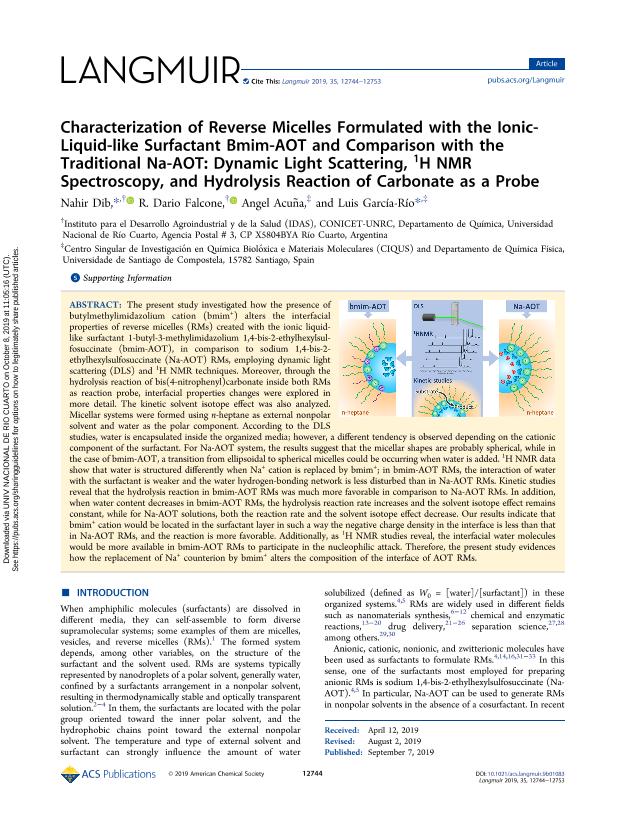Artículo
Characterization of reverse micelles formulated with the ionic-liquid-like surfactant Bmim-AOT and comparison with the traditional Na-AOT: Dynamic light scattering, 1H NMR spectroscopy, and hydrolysis reaction of carbonate as a probe
Fecha de publicación:
10/2019
Editorial:
American Chemical Society
Revista:
Langmuir
ISSN:
0743-7463
e-ISSN:
1520-5827
Idioma:
Inglés
Tipo de recurso:
Artículo publicado
Clasificación temática:
Resumen
The present study investigated how the presence of butylmethylimidazolium cation (bmim+) alters the interfacial properties of reverse micelles (RMs) created with the ionic liquid-like surfactant 1-butyl-3-methylimidazolium 1,4-bis-2-ethylhexylsulfosuccinate (bmim-AOT), in comparison to sodium 1,4-bis-2-ethylhexylsulfosuccinate (Na-AOT) RMs, employing dynamic light scattering (DLS) and 1H NMR techniques. Moreover, through the hydrolysis reaction of bis(4-nitrophenyl)carbonate inside both RMs as reaction probe, interfacial properties changes were explored in more detail. The kinetic solvent isotope effect was also analyzed. Micellar systems were formed using n-heptane as external nonpolar solvent and water as the polar component. According to the DLS studies, water is encapsulated inside the organized media; however, a different tendency is observed depending on the cationic component of the surfactant. For Na-AOT system, the results suggest that the micellar shapes are probably spherical, while in the case of bmim-AOT, a transition from ellipsoidal to spherical micelles could be occurring when water is added. 1H NMR data show that water is structured differently when Na+ cation is replaced by bmim+ in bmim-AOT RMs, the interaction of water with the surfactant is weaker and the water hydrogen-bonding network is less disturbed than in Na-AOT RMs. Kinetic studies reveal that the hydrolysis reaction in bmim-AOT RMs was much more favorable in comparison to Na-AOT RMs. In addition, when water content decreases in bmim-AOT RMs, the hydrolysis reaction rate increases and the solvent isotope effect remains constant, while for Na-AOT solutions, both the reaction rate and the solvent isotope effect decrease. Our results indicate that bmim+ cation would be located in the surfactant layer in such a way the negative charge density in the interface is less than that in Na-AOT RMs, and the reaction is more favorable. Additionally, as 1H NMR studies reveal, the interfacial water molecules would be more available in bmim-AOT RMs to participate in the nucleophilic attack. Therefore, the present study evidences how the replacement of Na+ counterion by bmim+ alters the composition of the interface of AOT RMs.
Palabras clave:
REVERSE MICELLES
,
BMIM-AOT
,
IONIC LIQUIDS
Archivos asociados
Licencia
Identificadores
Colecciones
Articulos (IDAS)
Articulos de INSTITUTO PARA EL DESARROLLO AGROINDUSTRIAL Y DE LA SALUD
Articulos de INSTITUTO PARA EL DESARROLLO AGROINDUSTRIAL Y DE LA SALUD
Citación
Dib, Nahir; Falcone, Ruben Dario; Acuña, Angel; García-Río, Luis; Characterization of reverse micelles formulated with the ionic-liquid-like surfactant Bmim-AOT and comparison with the traditional Na-AOT: Dynamic light scattering, 1H NMR spectroscopy, and hydrolysis reaction of carbonate as a probe; American Chemical Society; Langmuir; 35; 39; 10-2019; 12744-12753
Compartir
Altmétricas




